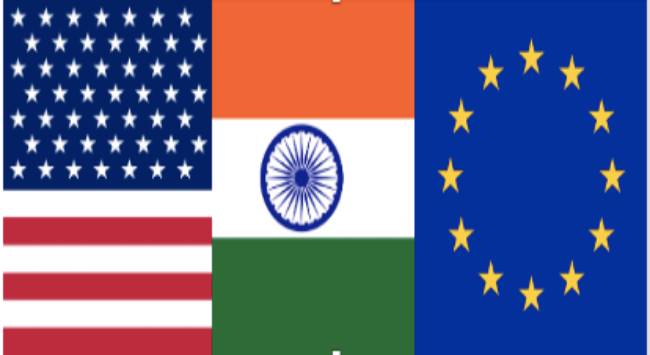Summary
India has moved to solidify two critical diplomatic partnerships through technology that could have far reaching effects.
In a matter of weeks, India has ambitiously expanded its technological partnerships with the United States (US) and the European Union (EU) through the US-India Initiative on Critical and Emerging Technology (iCET) and the EU-India Trade and Technology Council (TTC) respectively. Until till now, Delhi has largely refrained from collaborating closely on technology and digital issues, given the ostensible differences between India and the developed countries on key issues like data, digital economy and cybersecurity. These differences, for now, have been pushed aside, given the mutual desire to ensure technologies are developed fairly and openly.
The iCET emphasises values and principles and calls for New Delhi and Washington to help regulate and govern technologies through shared democratic values. Moreover, the initiative’s a recognition that the technological pillar of the US-India relations has lagged and needs some reviving as security ties have progressed apace. Increasingly, technology is being seen by American and Indian leaders and policymakers as integral to their security relationship, particularly competing against edging rivals like China. Access to critical and emerging technologies could tilt the security balance which necessitates close cooperation between partners to ensure such vital technologies are developed and distributed with sufficient protections and rules. The breadth of this initiative is notable as it calls for closer coordination between two thriving ‘innovation ecosystems’, connecting areas like biotechnology, critical minerals, quantum computing, artificial intelligence, space, 5G and rare earths. It also pushes both countries to deepen partners covering not only the government but also businesses, academic institutions, scientific establishments, think tanks and other organisations that contribute to technological innovation. The message is clear. Technologies are critical and should be a focal point of cooperation between India and the US bilaterally and at other multilateral and minilateral settings.
Like the US, EU-India relations have also become more strategic but are less focused on technology. Though the EU-India technology ties are not deep, the potential to deepen this partnership through the TTC exists, given the EU’s strengths and capabilities in areas like green and clean energy technologies and leadership shown by emphasising on technology standards globally. Like the iCET, the TTC also emanates from a desire to advance mutual economic and security interests through shared values that extends to the technology side. The TTC serves as a structure that allows both parties to coordinate policies on three areas through working groups – digital governance and connectivity; green and clean energy technologies; and supply chains. All three issues have become more important due to the pandemic and economic difficulties countries have experienced with rising inflationary trends. Moreover, the focus on green technologies appears timely as climate change concerns intensify, placing more expectations on leading emitters to drive decarbonisation.
The initial agenda on this pillar within the TTC focuses on how clean energy startups in India and the EU can work together. The TTC appears to have an ambitious but difficult agenda and details are scarce on how the different agencies will drive progress, given the prevailing impasse between the EU and India on some fundamental issues like data. China possibly looms large in EU-India strategic discussions that prompted this move but convergence also exists in terms of working together to devise new standards that govern critical technologies given the vacuum lingers globally vis-a-vis technology governance.
India’s ambitious techplomacy with the US and the EU presents promising opportunities and challenges for New Delhi. It shows that India is a digital power that has the clout and strength to lead globally on digital issues. The country’s impressive technological strides, namely, the India Stack, add to India’s comparative advantage in this domain. Additionally, investments made on programs like the United Payments Interface redound to India’s credentials and ability to lead digitally. Discussing all aspects of technology issues – from digital to biotechnology and semiconductors – allows New Delhi to gauge market opportunities that exist. This could then allow India to reorient priorities to fill those market gaps by developing and exporting high-end technology and digital services. It can use such innovative diplomatic partnerships to advance the internationalisation of open-source technologies built on open standards.
Institutionally, these novel technology partnerships testify to the importance of mainstreaming technology and digital issues within the Ministry of External Affairs and India’s diplomacy writ large. Yet, moving this agenda forward will require more dexterity and doggedness from Indian diplomats who will have to juggle this issue at multiple sites including the Quad and with other partners like Japan and South Korea. These officials will also have to coordinate and drive this agenda alongside non-governmental partners from business, think tanks, and academia. The time to have specialised ‘technology ambassadors’ who can handle technology and digital negotiations given India’s unique interests and objectives might have finally come.
. . . . .
Dr Karthik Nachiappan is a Research Fellow at the Institute of South Asian Studies (ISAS), an autonomous research institute in the National University of Singapore (NUS). He can be contacted at isaskn@nus.edu.sg. The author bears full responsibility for the facts cited and opinions expressed in this paper.
Pic Credit: Wikipedia Commons.
https://commons.wikimedia.org/wiki/File:Flag_of_the_United_States_(1912-1959).svg and https://commons.wikimedia.org/wiki/File:Flag_India.svg
-
 More From :
More From :
-
 Tags :
Tags :
-
 Download PDF
Download PDF


